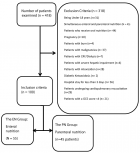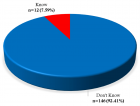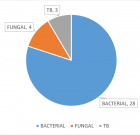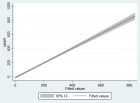Abstract
Research Article
Impact of the COVID-19 infection on the “benign” nature of the illness of Schönlein-Henoch
A Vasileva*, IV Chakarov and P Chakarova
Published: 11 January, 2022 | Volume 6 - Issue 1 | Pages: 007-010
The incidence of COVID-19 in children has been variable. Although now the number of infected children worldwide, and in particular nationally, is small, they are not protected from the infection. Moreover, in the most severe cases septic shock, metabolic acidosis, irreversible bleeding, and coagulation dysfunction have been registered.
In February 2021 a 17-year-old boy showed for examination with complaints of pain in the upper part of the abdomen, accompanied by involvement of the ankle joints, the appearance of a rash on the lower extremities with the characteristic of hemorrhagic vasculitis, and a positive test for COVID-19. The characteristics of the skin purpura, the abdominal pain, and the arthralgia led us to the diagnosis of Schönlein-Henoch purpura.
The verification of past COVID-19 infection was done by the established high titer of specific IgG antibodies. The clinical evolution of the disease went beyond its generally accepted benign nature - the first manifestation of the illness had been followed by four more relapses, which necessitated new hospitalizations and a change in the therapeutic approach.
COVID-19 infection is the cause of a more aggressive course of vasculitis.
Read Full Article HTML DOI: 10.29328/journal.ijcv.1001042 Cite this Article Read Full Article PDF
Keywords:
COVID-19; Henoch-Schönlein purpura; Abdominal pain
References
- Shi JS, Gu JY, Wang M. Clinical manifestations, gastroscopic, and pathological features of abdominal type Henoch-Schonlein purpura in children. Pediatr Nephrol. 2013; 28: 1424-1424.
- Hung SP, Yang YH, Lin YT, Wang LC, Lee JH, et al. Clinical manifestations and outcomes of Henoch-Schönlein purpura: comparison between adults and children. Pediatr Neonatol. 2009; 50: 162-168. PubMed: https://pubmed.ncbi.nlm.nih.gov/19750891/
- Mills JA, Michel BA, Bloch DA, Calabrese LH, Hunder GG, et al. The American College of Rheumatology 1990 criteria for the classification of Henoch-Schönlein purpura. Arthritis Rheum. 1990; 33: 1114-21. PubMed: https://pubmed.ncbi.nlm.nih.gov/2202310/
- Davies PJ. Mozart’s death: a rebuttal of Karhausen: further evidence for Schönlein-Henoch syndrome. J R Soc Med. 1991; 84: 737-740. PubMed: https://www.ncbi.nlm.nih.gov/pmc/articles/PMC1295524/
- Couture A, Veyrac C, Baud C, Galifer RB, Armelin I. Evaluation of abdominal pain in Henoch-Schönlein syndrome by high frequency ultrasound. Pediatr Radiol. 1992; 22: 12-17. PubMed: https://pubmed.ncbi.nlm.nih.gov/1594303/
- Martinez-Frontanilla LA, Haase GM, Ernster JA, Bailey WC. Surgical complications in Henoch-Schönlein Purpura. J Pedaitr Surg. 1984; 19: 434-436. PubMed: https://pubmed.ncbi.nlm.nih.gov/6481588/
- Besbas N, Saatci U, Ruacan S, Ozen S, Sungur A, et al. The role of cytokines in Henoch-Schonlein purpura. Scand J Rheumatol. 1997; 26: 456-460. PubMed: https://pubmed.ncbi.nlm.nih.gov/9433407/
- Saulsbury FT. Henoch-Schönlein purpura. Curr Opin Rheumatol. 2010; 22: 598-602. PubMed: https://pubmed.ncbi.nlm.nih.gov/20473173/
- Del Vecchio GC, Penza R, Altomare M, Picante L, Aceto G, et al. Cytokine pattern and endothelium damage markers in Henoch-Schönlein purpura. Immunopharmacol Immunotoxicol. 2008; 30: 623-629. PubMed: https://pubmed.ncbi.nlm.nih.gov/18668398/
- Dalens B, Travade P, Labbé A, Bezou MJ. Diagnostic and prognostic value of fibrin stabilising factor in Schönlein-Henoch syndrome. Arch Dis Child. 1983; 58: 12-14. PubMed: https://pubmed.ncbi.nlm.nih.gov/6830268/
- Kamitsuji H, Tani K, Yasui M, Taniguchi A, Taira K, et al. Activity of blood coagulation factor XIII as a prognostic indicator in patients with Henoch-Schönlein purpura. Efficacy of factor XIII substitution. Eur J Pediatr. 1987; 146: 519-523. PubMed: https://pubmed.ncbi.nlm.nih.gov/3678279/
- Bowyer SL, Ragsdale CG, Sullivan DB. Factor VIII related antigen and childhood rheumatic disease. J Rheumatol. 1989; 16: 1093-1097. PubMed: https://pubmed.ncbi.nlm.nih.gov/2585406/
- Nusinow SR, Federici AB, Zimmerman TS, Curd JG. Increased von Willebrand factor antigen in the plasma of patients with vasculitis. Arthritis Rheum. 1984; 27: 1405-1410. PubMed: https://pubmed.ncbi.nlm.nih.gov/6508862/
- Woolf AD, Wakerley G, Wallington TB, Scott DGI, Dieppe PA. Factor VIII related antigen in the assessment of vasculitis. Ann Rheum Dis. 1987; 46: 441-447. PubMed: https://pubmed.ncbi.nlm.nih.gov/3115202/
- Vasavada P. Ultrasound evaluation of acute abdominal emergencies in infants and children. Radiol Clin North Am. 2004; 42: 445-456. PubMed: https://pubmed.ncbi.nlm.nih.gov/15136027/
- Ozdemir H, Isik S, Buyan N. Sonographic demonstration of intestinal involvement in Henoch-Schönlein syndrome. Eur J Radiol. 1995; 20: 32-34. PubMed: https://pubmed.ncbi.nlm.nih.gov/7556249/
- Bomelburg T, Claasen U, von Langerke HJ. Intestinal ultrasonographic findings in Schönlein-Henoch syndrome. Eur Pediatr. 1991; 150: 158-160. PubMed: https://pubmed.ncbi.nlm.nih.gov/2044583/
- Yang HR, Choi WJ, Ko JS, Seo JK. Intravenous immunoglobulin for severe gastrointestinal manifestation of Henoch-Schönlein purpura refractory to corticosteroid therapy. Korean Pediatr. 2006; 69: 798-806. PubMed: https://pubmed.ncbi.nlm.nih.gov/27133370/
- Ebert EC. Gastrointestinal manifestations of Henoch-Schonlein purpura. Dig Dis Sci. 2008; 53: 2011-2019. PubMed: https://pubmed.ncbi.nlm.nih.gov/18351468/
- Fukui H, Kamitsuji H, Nagao T, Yamada K, Akatsuka J, et al. Clinical evaluation of a pasteurizes factor XIII concentrate administration in Henoch-Schönlein purpura. Thromb Res 1989; 56: 447-75.
Figures:

Figure 1

Figure 2
Similar Articles
-
Pseudoephedrine protects mice from infection of H1N1 virusZhongping Wu*,Li Deng,Chengzhi Chu,Xiaoyin Chen*. Pseudoephedrine protects mice from infection of H1N1 virus. . 2020 doi: 10.29328/journal.ijcv.1001008; 4: 014-020
-
The Psychology of the Common Cold and Influenza: Implications for COVID-19Andrew P Smith*. The Psychology of the Common Cold and Influenza: Implications for COVID-19. . 2020 doi: 10.29328/journal.ijcv.1001011; 4: 027-031
-
Yemen is free of COVID-19Hussein O Kadi*. Yemen is free of COVID-19. . 2020 doi: 10.29328/journal.ijcv.1001012; 4: 032-033
-
Exploring pathophysiology of COVID-19 infection: Faux espoir and dormant therapeutic optionsVinod Nikhra*. Exploring pathophysiology of COVID-19 infection: Faux espoir and dormant therapeutic options. . 2020 doi: 10.29328/journal.ijcv.1001013; 4: 034-040
-
COVID-19: Targeting the cytokine storm via cholinergic anti-inflammatory (Pyridostigmine)Ahmed H Osman*. COVID-19: Targeting the cytokine storm via cholinergic anti-inflammatory (Pyridostigmine). . 2020 doi: 10.29328/journal.ijcv.1001014; 4: 041-046
-
Identifying patterns in COVID-19: Morbidity, recovery and the aftermathVinod Nikhra*. Identifying patterns in COVID-19: Morbidity, recovery and the aftermath. . 2020 doi: 10.29328/journal.ijcv.1001016; 4: 056-064
-
Role of nanotechnology in diagnosing and treating COVID-19 during the PandemicAbdul Baset*,Abdul Waris,Muhammad Ali,Atta Ullah Khan,Asmat Ali. Role of nanotechnology in diagnosing and treating COVID-19 during the Pandemic. . 2020 doi: 10.29328/journal.ijcv.1001017; 4: 065-070
-
COVID-19: The possible medical strategiesMohamed SA Mohamed*. COVID-19: The possible medical strategies. . 2020 doi: 10.29328/journal.ijcv.1001018; 4: 071-075
-
Inhaled statins to combat COVID-19 – prophylactic and treatment approachArchana P Iyer*,Maryam A Al-Ghamdi. Inhaled statins to combat COVID-19 – prophylactic and treatment approach. . 2020 doi: 10.29328/journal.ijcv.1001020; 4: 079-080
-
A Comprehensive review on genomic diversity and epidemiology of COVID-19Zeshan Haider Raza*,Muhammad Ahmed Ihsan,Sahrish Khan,Haroon Zafar,Tayyaba Rehman. A Comprehensive review on genomic diversity and epidemiology of COVID-19. . 2020 doi: 10.29328/journal.ijcv.1001021; 4: 081-095
Recently Viewed
-
Misoprostol Usage in the Kingdom of Bahrain: A Retrospective StudyMaryam Alsalem*,Hosni Malas,Gulmeen Raza,Rehab Ismael. Misoprostol Usage in the Kingdom of Bahrain: A Retrospective Study. Clin J Obstet Gynecol. 2025: doi: 10.29328/journal.cjog.1001196; 8: 092-095
-
ERRATUM to: Fiesta vs. Stress Condition the Incidence and the Age at Menarche. Forty Years of ResearchCarlos Y. Valenzuela*. ERRATUM to: Fiesta vs. Stress Condition the Incidence and the Age at Menarche. Forty Years of Research. Clin J Obstet Gynecol. 2025: doi: 10.29328/journal.cjog.1001190(E); 8:
-
Fiesta vs. Stress Condition the Incidence and the Age at Menarche. Forty Years of ResearchCarlos Y Valenzuela*. Fiesta vs. Stress Condition the Incidence and the Age at Menarche. Forty Years of Research. Clin J Obstet Gynecol. 2025: doi: 10.29328/journal.cjog.1001190; 8: 069-073
-
Obstetric Paradoxes and Didactic Equations: The Impact of Mathematical Teaching on Childbirth and BeyondPascual Chiago*. Obstetric Paradoxes and Didactic Equations: The Impact of Mathematical Teaching on Childbirth and Beyond. Clin J Obstet Gynecol. 2025: doi: 10.29328/journal.cjog.1001197; 8: 096-101
-
Intravenous Leiomyomatosis of the Uterus with Intracardiac ExtensionTomas Reyes-del Castillo*,Minerva I Hernandez-Rejon,Jose L Ruiz-Pier,Mario Peñaloza-Guadarrama,Carlos E Merinos-Avila,Cristina Juarez-Cabrera,Pedro A del Valle-Maldonado,Sofia Ley-Tapia,Valentín Gonzalez-Flores. Intravenous Leiomyomatosis of the Uterus with Intracardiac Extension. Arch Vas Med. 2025: doi: 10.29328/journal.avm.1001021; 9: 003-007
Most Viewed
-
Feasibility study of magnetic sensing for detecting single-neuron action potentialsDenis Tonini,Kai Wu,Renata Saha,Jian-Ping Wang*. Feasibility study of magnetic sensing for detecting single-neuron action potentials. Ann Biomed Sci Eng. 2022 doi: 10.29328/journal.abse.1001018; 6: 019-029
-
Evaluation of In vitro and Ex vivo Models for Studying the Effectiveness of Vaginal Drug Systems in Controlling Microbe Infections: A Systematic ReviewMohammad Hossein Karami*, Majid Abdouss*, Mandana Karami. Evaluation of In vitro and Ex vivo Models for Studying the Effectiveness of Vaginal Drug Systems in Controlling Microbe Infections: A Systematic Review. Clin J Obstet Gynecol. 2023 doi: 10.29328/journal.cjog.1001151; 6: 201-215
-
Causal Link between Human Blood Metabolites and Asthma: An Investigation Using Mendelian RandomizationYong-Qing Zhu, Xiao-Yan Meng, Jing-Hua Yang*. Causal Link between Human Blood Metabolites and Asthma: An Investigation Using Mendelian Randomization. Arch Asthma Allergy Immunol. 2023 doi: 10.29328/journal.aaai.1001032; 7: 012-022
-
Impact of Latex Sensitization on Asthma and Rhinitis Progression: A Study at Abidjan-Cocody University Hospital - Côte d’Ivoire (Progression of Asthma and Rhinitis related to Latex Sensitization)Dasse Sery Romuald*, KL Siransy, N Koffi, RO Yeboah, EK Nguessan, HA Adou, VP Goran-Kouacou, AU Assi, JY Seri, S Moussa, D Oura, CL Memel, H Koya, E Atoukoula. Impact of Latex Sensitization on Asthma and Rhinitis Progression: A Study at Abidjan-Cocody University Hospital - Côte d’Ivoire (Progression of Asthma and Rhinitis related to Latex Sensitization). Arch Asthma Allergy Immunol. 2024 doi: 10.29328/journal.aaai.1001035; 8: 007-012
-
An algorithm to safely manage oral food challenge in an office-based setting for children with multiple food allergiesNathalie Cottel,Aïcha Dieme,Véronique Orcel,Yannick Chantran,Mélisande Bourgoin-Heck,Jocelyne Just. An algorithm to safely manage oral food challenge in an office-based setting for children with multiple food allergies. Arch Asthma Allergy Immunol. 2021 doi: 10.29328/journal.aaai.1001027; 5: 030-037

If you are already a member of our network and need to keep track of any developments regarding a question you have already submitted, click "take me to my Query."


















































































































































